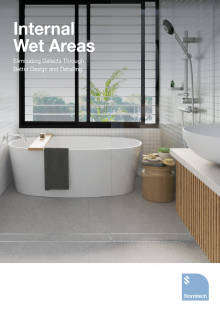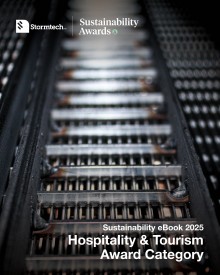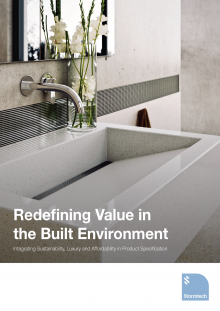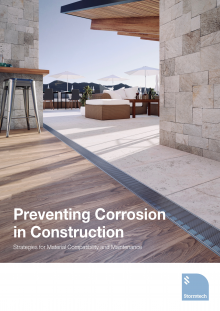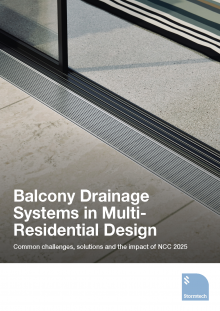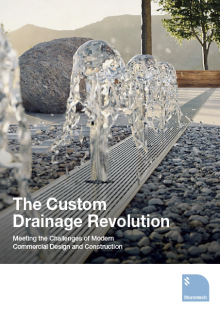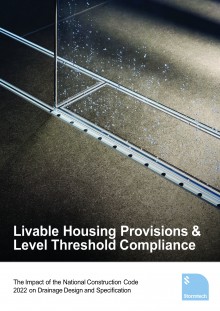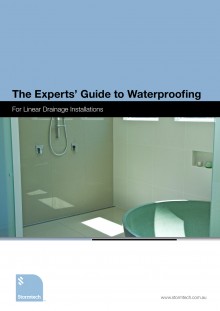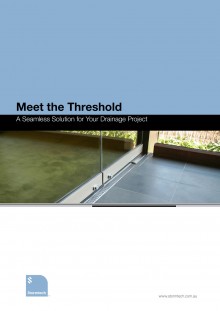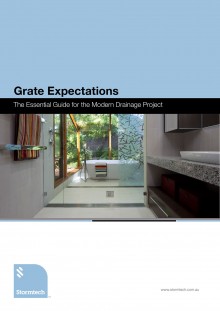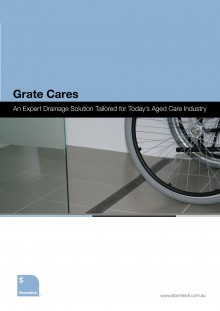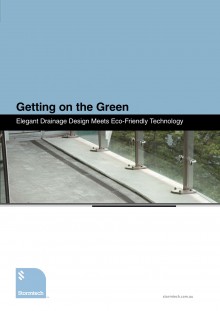Stormtech Whitepapers
The page contains our collection of White Papers produced for Stormtech products and services.
Choose a Whitepaper topic to download or print the PDF.
Internal Wet Areas: Eliminating Defects Through Better Design and Detailing
Bathrooms and wet areas continue to rank among the most defect-prone areas of construction in Australia, with waterproofing and drainage failures a persistent problem. Industry studies show that between 20% and 40% of apartment buildings experience some form of waterproofing defect, highlighting systemic shortcomings in current practice. It is important for design professionals to understand approaches that can reduce failure points and deliver reliable wet area performance. Internal Wet Areas: Eliminating Defects Through Better Design and Detailing examines the underlying causes of recurring wet area defects and identifies the challenges with current industry practice. It sets out a more effective approach to wet area design, providing strategies to reduce complexity and minimise potential failure points. With a focus on shower areas and drainage, this paper also equips architects with clear guidance to achieve wet areas that are both streamlined in execution and reliable in long-term performance. For more than 30 years, Stormtech has delivered innovative architectural drainage solutions for bathrooms, showers, thresholds, paved areas, driveways and pools. Renowned for sleek design and practical performance, Stormtech linear drainage systems are manufactured in Australia from high-quality 316 stainless steel and are available in both Made-to-Length and modular formats that can be cut on-site to suit project needs. Download this paper to explore approaches to improving wet area design and reducing defects through smarter detailing and product specification.
Download Whitepaper
Sustainability eBook 2025
Download the official Stormtech 2025 Sustainability eBook for exclusive insights into truly sustainable Australian manufacturing. Discover how Stormtech is setting the global standard for environmentally responsible drainage solutions: Solar-Powered Production: Our NSW manufacturing plant operates entirely on renewable solar energy, cutting over 260 tonnes of carbon emissions annually. Low-Carbon Materials: Learn about our procurement of the world's lowest-carbon materials, including 90%+ recycled 316-grade stainless steel and Capral Super Green aluminium for the award-winning Wave Grate. Industry Validation: Global Greentag EPD & LCARate certification on slimline linear drainage, Best Environmental Practice PVC Ethical Supply Chain: Understand the value of Australian-made production, ensuring full control over ethical practices and high quality for architects and specifiers. Specify lower embodied carbon solutions and contribute to Green Star buildings. Download the free eBook today and explore how thoughtful design can create resilient, future-focused built environments.
Download Whitepaper
Redefining Value in the Built Environment
Integrating Sustainability, Luxury and Affordability in Product Specification Despite increasing regulatory pressure for sustainable building practices, a common misconception persists within the construction industry: that luxury, affordability, and sustainability are inherently incompatible. This paper challenges that notion by presenting a framework that allows architects and designers to integrate high-end aesthetics with strong environmental and economic performance. Drawing on current design trends and lifecycle assessment, we propose an approach that evaluates materials and systems based on three overlapping objectives: Sustainability: Minimizing environmental impact through factors like low embodied carbon, responsible sourcing, and end-of-life considerations. Affordability: Achieving cost-effectiveness over a building's lifespan by prioritizing durability, efficiency, and ease of maintenance. Luxury: Delivering refined design outcomes through superior material quality, enhanced user comfort, health, and sensory experience. Through this lens, we demonstrate how these seemingly disparate concepts can be aligned through strategic material selection, finish specification, and system integration.
Download Whitepaper
Preventing Corrosion in Construction: Strategies for Material Compatibility and Maintenance
In the built environment, the durability of structures hinges on thoughtful material selection and the implementation of sound design principles. While architects, engineers, and building designers often possess a practical understanding of material compatibility, this knowledge can become fragmented as projects progress from design to construction. As a result, incompatible materials may be used, or maintenance practices adopted by end users may inadvertently compromise the integrity of a structure. These mistakes can significantly impact the long-term performance of buildings and lead to costly remediation efforts. Corrosion, a pervasive issue in construction, exemplifies the risks of overlooking material compatibility. Defined as the chemical degradation of materials, corrosion manifests in various forms, such as rust and staining, and can be influenced by environmental factors, material pairings, and chemical exposure. According to the Australasian Corrosion Association, corrosion costs the Australian economy an estimated $78 billion annually—a financial burden that is largely preventable. This paper examines the common causes of corrosion within the context of architecture and construction, emphasising the critical role of material compatibility in mitigating these challenges. It explores how strategic design decisions can minimise corrosion risks and underscores the value of proactive maintenance to extend the life cycle of materials.
Download Whitepaper
Balcony Drainage Systems in Multi-Residential Design
Balconies are a popular feature in multi-residential buildings, offering occupants an appealing blend of indoor and outdoor living. However, these spaces present specific challenges in terms of drainage, making careful design of water management systems essential. Without proper drainage, balconies are susceptible to water accumulation, which can lead to structural issues, building degradation and discomfort for residents. As multi-residential developments continue to expand across Australia, the complexity of balcony designs has grown. This has resulted in a higher number of building defects, particularly in relation to waterproofing failures, ingress and leaks. Such issues are a growing concern for architects, developers, and designers striving to create durable and reliable structures. Addressing these defects is critical, as they impact not only the longevity of the building but also the satisfaction of both owners and occupants. Poor drainage design can result in costly maintenance and repairs, underscoring the importance of considering water management early in the design phase of multi-residential balcony projects. In this whitepaper, we look at why balconies leak and the drainage solutions that will prevent water accumulating and entering the indoor environment. We also consider the upcoming changes related to this field in the 2025 update of the National Construction Code (NCC).
Download Whitepaper
The Custom Drainage Revolution
In complex spaces, such as those with unique layouts, particular aesthetic requirements, or difficult environmental conditions, standard drainage solutions may not always be effective. This is where customised drainage solutions come into play, providing individualised solutions to challenging drainage problems that are beyond the scope of standard “off-the-shelf” products. The Custom Drainage Revolution: Meeting the Challenges of Modern Commercial Design and Construction examines how custom drainage systems can meet the challenges faced by today’s building projects. Custom-designed drainage solutions excel in complex spaces because they are made from the ground up to satisfy the unique requirements of a project, guaranteeing a drainage system that precisely satisfies the space's functional and aesthetic requirements. Stormtech™ offers a tailored site-specific service to suit the complex needs of large and intricate projects, including a free site measure and quote. Linear drainage systems can be customised to suit unique design challenges, including dimensions, load, capacity, slip resistance and grate colour finishes, to give specifiers, trades and end users complete confidence that the products they are using are fit-for-purpose, and built for the required application.
Download Whitepaper
Waterproofing of domestic wet areas
Water seeping into adjacent building elements due to improper floor grading and inadequate waterproof membrane installation in key areas, such as around the floor waste, frequently results in building damage. To avoid these issues, architects, designers and specifiers need to have a thorough understanding of the changes to floor waste, floor grading and waterproofing requirements in the 2021 version of AS 3740 “Waterproofing of domestic wet areas” and the 2022 update of the National Construction Code. Understanding AS 3740:2021 “Waterproofing of domestic wet areas”: A Guide to Floor Waste and Fall Requirements examines how the recent updates to the relevant standards and regulations impact wet area design and construction. Two of the most frequently reported building issues are improper floor grading in wet areas and non-compliance with waterproofing regulations. The most basic objective of any construction project should be to keep our buildings and people safe and preventing loss of amenity. This is more easily achieved by first understanding and then exceeding the requirements for wet area waterproofing in terms of material, design, and installation. Stormtech’s 120SCS Shower Screen Support drain will help you meet and exceed the new requirements in the NCC 2020 and AS 3740:2021 while at the same time drastically simplifying bathroom design and installation. This innovative product, which includes a Shower Screen Support Channel for any Stormtech grating style, is a versatile linear drainage system that provides dual functions as a drain for both sides of the shower screen and a support for the shower screen itself.
Download Whitepaper
Beyond The Building Code
Building codes play a significant role in determining a building's long-term quality, safety, and energy efficiency. In Australia, this is fulfilled by the National Construction Code (NCC), which specifies the minimum necessary requirements for safety, health, amenity, and sustainability in the design and construction of new buildings (and new building work in existing buildings). Design and construction choices affect operational performance and maintenance costs during the lifetime of the building. Building codes, such as the NCC, help designers and builders “get it right” from the start. Once installed, some building components may be replaceable or upgradeable, but some aspects of how the building performs are “baked” into the design. This is especially the case for plumbing and waterproofing. Due to various factors—from stronger fire safety regulations to higher expectations for liveability—building regulations have grown more onerous in recent years. This, along with increases in the cost of materials and labour, has seen the cost of construction rise to some of the highest levels we have ever seen. “Chasing the minimum” is the default stance many architects, designers, and builders take when faced with the need to increase margins and deliver projects on schedule. This practice involves constructing buildings to the bare minimum, following the regulatory requirements to the letter, and making no attempt to exceed the performance level or specification set by the standard—even if doing so would result in better building performance over the long run. Is this a mistake?
Download Whitepaper
Tried and Tested: Exploring Issues with Building Product Certification
With the rising cost of construction and supply chain issues across the globe, all parties in the building and procurement process need to be on guard and informed of the risks of products that fail to meet performance claims or fall short of Australian standards. Understanding the regulatory pathways used to ensure product conformance is especially important given the expanding variety of new and innovative products that are being sold. Product certification is a tool that can be used to ensure a product is compliant and fit-for-purpose, but the landscape is more complex than it appears. Tried and Tested: Exploring Issues with Building Product Certification is a useful guide to building product certification schemes and how they can help you reduce risk. We explain what certification means in relation to building products and provide examples of certification schemes relevant to the Australian building sector, including WaterMark. We discuss some potential misuses of certification to help building and design professionals avoid the most common pitfalls. We also look at several effective ways to reduce the risks associated with incorrect product specification. All Stormtech drains are Watermark certified for use in Australia. Stormtech is also the only drainage manufacturer with GreenTag Level A Gold certification, which is the product rating certification approved by the Green Building Council of Australia. Stormtech works proactively with plumbing advisory services to ensure drainage remains fully compliant with NCC regulations and Australian standards and exceeds the minimums to ensure not only fit for purpose, but reliability and durability.
Download Whitepaper
Livable Housing Provisions & Level Threshold Compliance
Drainage maintains a straightforward but crucial function: making sure water can be removed from the property effectively, safely, and efficiently. This is not only important in bathrooms to avoid pooling water and unsafe conditions, but also in the transition between indoor and outdoor spaces. An effective drainage system prevents water ingress by draining it away, all the while ensuring a level transition between the two spaces. The National Construction Code (NCC) 2022 edition has new provisions that will make new Australian homes more suitable for people with mobility issues. New livable housing design requirements are included in the updated Code, changing the way we design homes to make them easier to use and more adaptable to the changing needs of occupants. Based on the Livable Housing Design Guidelines (silver level), first published by Livable Housing Australia, these new requirements represent a significant improvement in the housing options available to older Australians and those with physical disabilities. In practice, this entails eliminating steps whenever possible, creating more room in the bathroom, enlarging doorways, and making provisions for future modifications like the installation of grab rails.
Download Whitepaper
Going Local Amid the Global Supply Chain Crisis
When designing and manufacturing plumbing and drainage systems in Australia, one of the first decisions you have to make is whether to make the product locally or outsource it from overseas. While the industry assumption is that it is more cost effective to manufacture offshore, this is not necessarily the case given the current instability in global supply chains.
Download Whitepaper
Safety Lessons - A Specifier's Guide to Creating Safe & Sustainable Educational Facilities
In this whitepaper, we provide a concise look at the design standards that apply to schools in Australia and examine the key considerations when specifying for these facilities, with a particular focus on child-specific safety risks and sustainability requirements. In doing so, we provide designers and specifiers with the essential knowledge they need to create safe and sustainable learning spaces that meet the needs of a wide variety of end users.
Download Whitepaper
Considerations When Selecting a Sustainable Drainage Provider
Amidst the rapidly expanding local and global construction sectors, sustainability is a key concern. Architects and specifiers must navigate a tricky terrain of mandatory regulation and compliance hurdles, coupled with growing social pressure and, importantly, their own drive to make a positive impact on the world. With growing numbers of home buyers and renters concerned about the sustainability credentials of their dwellings and increasingly willing to pay more for sustainable residences, the writing is on the wall. Architects and specifiers continue to rise to the challenges of increasingly sustainable architecture and now lead the charge with ever-more innovative solutions. This whitepaper will provide a detailed overview of factors for consideration by architects and specifiers when choosing a renowned, industry-leading drainage supplier to deliver effective sustainable drainage solutions.
Download Whitepaper
Aging In Place
New homes that are being built now by first or second time homeowners are likely to be the homes that they live in into old age. New builds need to prioritise safety, accessibility and comfort to meet the needs of occupants now and into the future. Among the key design priorities include, eliminating trip hazards, mobility considerations and facilitating daily living activities such as bathing, grooming and cooking. If such requirements are not considered early, the homeowner will face costly house modifications as they age.
Download Whitepaper
Style and Function: Specifying linear drainage systems for the hospitality industry
For the past five years, the Australian hospitality industry enjoyed a sustained period of growth. Buoyed by high tourist numbers and plentiful investment, it moved from strength to strength - and naturally a strong foundation of hospitality-focused architectural projects accompanied the boom. However the global economic havoc caused by the COVID-19 pandemic has decimated the industry - both in real terms and in short-term growth potential. At the time of writing, in March 2020, businesses are closing, full rosters of employees being laid off and future investment in the sector has all but dried up as the world waits to see just how protracted the fallout will be.
Download Whitepaper
Form and Function- Current Bathroom trends
Bathrooms may not be where the majority of anyone’s time is spent, but they do adopt a particularly important role within our homes with their baseline purposes of hygiene and waste management. This has been recognised by the industry, which has shifted its focus towards the development of products that place equal weighting on functionality and aesthetics. Form and Function: Current Trends in Bathroom Design examines a variety of the industry’s current concerns, and how they are reflected in the products currently being produced. These issues include sustainable design, healthy living, comfort and personalisation, digital and technological integration, as well as reducing maintenance requirements. By tackling these issues, current products are tapping into an area of development that moves past innovation for its own sake – instead creating long-term value for clients.
Download Whitepaper
Tips to avoid a Tiling Disaster
While tiles are one of the main visual elements of any bathroom or outdoor area, understanding their role in a much larger system is imperative in order to avoid a tiling disaster. Rather than being an isolated product, tiling from a practical perspective makes up only one portion of drainage and waterproofing, complementary to substrates, waterproofing membranes, sanitary ware, tap ware and the drainage itself. A failure to address all of these components as a system can lead to the leakage of water into floor spaces or wall cavities, causing incredible amounts of damage before any physical evidence of such reveals itself.
Download Whitepaper
Grate Cares
Faced with a rapidly aging population, Australia’s care facilities are experiencing overwhelming demand for their services. With increased demand comes the inevitable push to expand, upgrade or re-furbish facilities: critical to ensuring the ongoing health, wellbeing and autonomy of residents. Accessibility and ease-of-mobility remain key focus points in the design and construction of today’s aged care facilities. After all, a misplaced step or sharp gradient fall could put frail residents at risk of a serious fall injury – the leading cause of death from injury for those aged 65 and over. Frequently overlooked, traditional drainage solutions present one of the most insidious and prohibitive barriers to universal access within the aged care setting. Step-downs, uneven floor surfaces, and high gradient falls are among the most dangerous and pervasive hazards for vulnerable residents; yet with the right design solution, these hazards can be mitigated or eliminated entirely. Specifically designed to eliminate the access hazards of conventional ‘step-down’ barrier drainage, lineal drainage is a cutting-edge ‘zero stepdown’ drainage solution for both indoor and outdoor applications. Unlike conventional drainage, this level-plane (i.e. flush with the ground surface) drainage solution requires no hob and only a single gradient fall, providing seamless access possibilities for residents and staff. Lineal designs conform to the strict accessibility requirements of AS1428 (Access and Mobility), while ensuring superior water conveyance and egression.
Download Whitepaper
Getting on the Green
Stormwater runoff is a major contributor to the degradation of Australia’s water catchments. The impact of unchecked urban sprawl has raised the stakes for architects, specifiers, builders and legislators to collectively improve the quality of urban drainage. A high-quality drainage solution can greatly reduce one’s negative impact on our waterways. Consistent drain flow will ensure material debris and pollutants are not collected, absorbed and conveyed during heavy downpours. Nevertheless, drainage positioning, installation and build quality all significantly impact on the quality of outflows.
Download Whitepaper
How Proper Planning can stop your project going down the drain
Drains are a vital element of any residential or commercial project. When properly installed, they are effectively out of sight and out of mind, and ensure that important everyday activities including bathing, cooking, and washing can be done safely and efficiently. Unfortunately, drain planning is an often-overlooked element of the construction process. In this whitepaper, How Proper Planning Can Stop Your Project Going Down the Drain, we take a closer look at the importance of planning drain installations. The whitepaper outlines the main factors that must be taken into account when planning a drain: location, drainage style, timing of construction, and regulatory compliance and details the complex regulatory framework surrounding drainage products in Australia.
Download Whitepaper
Drainage Selection Guide: 15 Common Applications Areas
The bathroom, and specifically the shower, is often thought of as the most important space to ensure good drainage. However, there are many other spaces that require consideration in relation to adequate drainage. This whitepaper addresses 15 different potential drainage application areas into clear sections, and highlights the importance of ensuring proper drainage in each area. In each section, potential safety hazards, installation shortfalls, and area-specific challenges are identified. The paper goes on to explain how in most cases, Stormtech’s linear drainage systems offer the best solution to these problems.
Download Whitepaper
Compliance of Regulations and Why It Matters
The issue of non-conforming and non-compliant products affects every stakeholder in the building industry. By ignoring regulations, building professionals endanger, not only their own reputation, but also the status of the entire industry. The plumbing industry has a number of regulations that are important to adhere to. Aspects like minimum size requirements, load restrictions and accessibility are vital for the success of plumbing and drainage systems. In this white paper, we examine why it is important that everyone plays by the rules.
Download Whitepaper
The Pitfalls of Investing in Low Grade Drainage
The importance of choosing compliant and conforming products in construction is regularly discussed in the media and within the industry. The most dramatic examples of the failure of substandard products – such as the Melbourne Docklands fire and the Infinity cable recall – are widely broadcast, yet the range of implications involved in choosing cheaper products remain largely underreported. For building professionals, it is important that the hallmarks of sub-standard drainage systems are easily identified so informed decisions can be made. Products demonstrating reduced flexibility can signal low quality, as they are only relevant for general applications. A cheap solution also suggests a lack of testing, or a short research and development period, which could lead to problems later down the line.
Download Whitepaper
Specifying Balcony Drainage Systems
Balcony design, and in particular drainage systems are a critical design consideration for multi-residential developments. Balconies are an external element of the building that must be properly integrated to work with the internal elements of the building. Balconies require appropriate drainage and isolation from the internal elements of the building.
Download Whitepaper
The Pacific Bondi Case study
In December 2015 Bondi’s newest development, Pacific Bondi, was completed, taking the areas luxury living to a whole new level. To meet the requirements of the hostile beachfront environment, as well as the expected high-traffic hotel and public areas, Stormtech supplied 316 marine grade stainless steel linear drainage for the bathrooms, balconies and panoramic atrium areas.
Download Whitepaper
Specification Guide To Pool Area Drainage
A review of specification of drainage products for architects, landscape architects and garden designers to sustainably design for high capacity water flow.
Download Whitepaper
The Experts Guide to Waterproofing
The Stormtech guide to ensuring your linear drainage waterproofing is installed correctly.
Download Whitepaper

